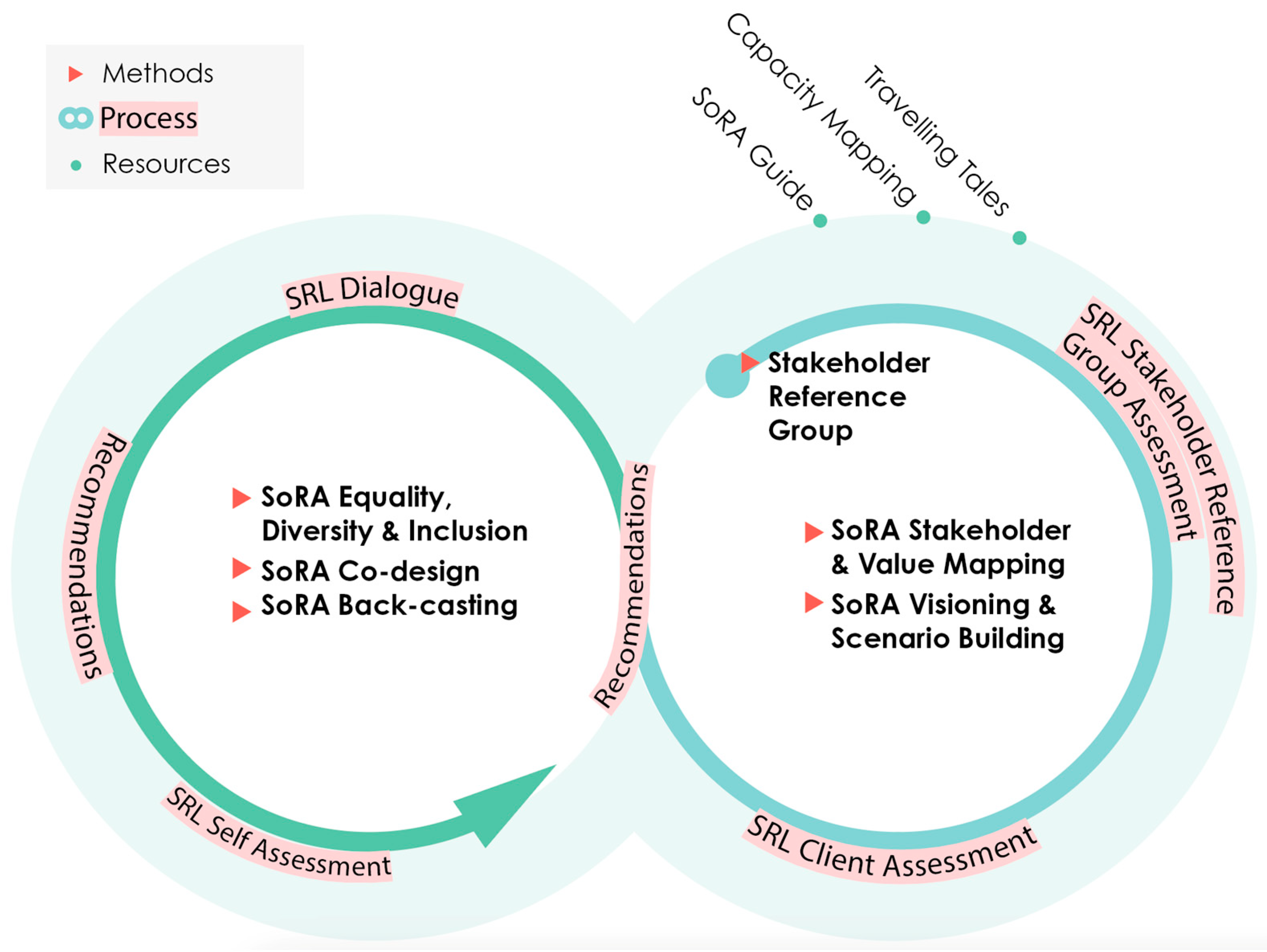Making Response-Ability: Societal Readiness Assessment for Sustainability Governance
Abstract
1. Introduction
2. Research Background
2.1. Ready or Not?
2.2. Technology Readiness Assessment
2.3. Wicked, Super-Wicked, or Plain Complex?
- ‘There is no definitive formulation of a wicked problem… The information needed to understand the problem depends upon one’s idea for solving it’ [50]: 161.Sustainability governance is shaped by different conceptions of solutions, each linked to a different way of understanding the problem. While many highway engineers see a need to build more roads and EV charging infrastructures, in Urry’s analysis, mobility governance has to aim for system change [51]. For the former, automobility is an unquestioned human need. For the latter, it is a historically contingent system combining: (1) the car made by iconic firms of 20th century capitalism; (2) sign-values such as speed, security, masculinity, status, and freedom; (3) a complex of industries from oil states to tourism, suburbian house building, and advertising; (4) land-use policies and global practices of automobility that subordinate other mobilities and shape childhood, work, family life, leisure and pleasure; (5) a dominant culture that holds mobility as central to the good life; and (6) unsustainable resource-use.
- ‘Wicked problems have no stopping rule. In solving a chess problem or a mathematical equation, the problem solver knows when he [sic] has done his job. … Not so with planning problems … because there are no ends to the causal chains’ (p. 162).The definition of ‘net-zero’ mobility is contested, and even Geels and Turnheim (who take a more mechanistic view than Urry) show that in 2022 no country ‘has yet presented a realistic and feasible implementation policy plan’ [52]: xiii. They agree with Urry that mobility demands whole system reconfiguration. However, there is no clear end state for any of these reconfigurations when the problem could be considered solved.
- ‘Solutions to wicked problems are not true-or-false, but good-or-bad’ (p. 162).Pangbourne et al.’s examination of MaaS, which integrates different modes of transport under digital service models, shows how this ‘solution’ has many ‘unanticipated and perverse outcomes ranging from changes in travel behaviour and attitudes to changes in land use and land value affecting urban form, as well as impacts on certain social groups’ [30]: 36. For example, MaaS Pay As You Go packages can disproportionately disadvantage the poor.
- ‘There is no immediate and no ultimate test of a solution …’ (p. 163).Societal effects of mobility innovations often only emerge over time and after significant investment has been made. Pangbourne et al. and the car-free observatory’s findings illustrate this.
- Each response to a wicked problem ‘is a “one-shot operation”; because there is no opportunity to learn by trial-and-error, every attempt counts significantly’ (p. 163).Opting for policies that rely on the electrification of automobility requires significant investment in infrastructures and could lock societies even deeper into automobility, where ‘EVs will claim much of the same urban spaces that green mobilities such as cycle lanes, bus lanes, and pedestrianization of cities also lay claim to …. A new battle over urban space—curbs, parking, buildings, and priority use of public streets—is likely to break out between EVs and green mobility’ [15]: 2003.
- ‘Wicked problems do not have an … exhaustively describable set of potential solutions’ (p. 164).There is no one right ‘solution’ to net-zero compatible mobility. Urry forsees a postautomobility system where ‘[s]uddenly automobility disappears’, as a tipping point ‘will occur during the 21st century, when the steel and petroleum car system will finally be seen as a dinosaur’ (p. 36). Geels and Turnheim, in contrast, envisage that ‘electric vehicles are likely to substantially reconfigure parts of the passenger mobility system’ (p. 219). There are many possible innovations and combinations of innovations, but methods for assessment beyond TRL are lacking.
- ‘Every wicked problem is essentially unique’ (p. 164).Mobility systems have very localised idiosyncracies, linked to topography, weather, demographics, and other complex factors. In the North of England, for example, the place-based carbon calculator created by the Centre for Research into Energy Demand Solutions, shows that carbon emissions are socially diverse [53]. There are high emissions from prospering countryside life and ageing suburbanites. Urban communities, as well as challenged communities, have lower emissions. This diversity poses different challenges for different local authorities. Place-based solutions are needed (Figure 1). Again, criteria for assessment are lacking.
- ‘Every wicked problem can be considered a symptom of another problem’ (p. 165).High-carbon automobility is still dominant, in no small part because land-use problems and investment decisions that separate work, education, and other public services from homes create systemic lock-ins, and car manufacturing and fossil fuel interests influence governments, media, and the public.
- ‘The choice of explanation determines the nature of the resolution’ (p. 166).This is the flipside of characteristic 1. If high carbon mobility is seen as a problem of demand and choice of fuel, electric vehicles and more infrastructure will look like solutions. If it is seen as an effect of maladaptive automobility land-use patterns, 15 min neighbourhoods and many other innovations enter the frame.
- ‘The planner has no right to be wrong’. Their decisions ‘matter a great deal to those people that are touched by those actions’ (p. 166).Many interventions are good or bad in highly consequential ways for different people. Planners and innovators are morally responsible, but there are also political consequences, as they may be accountable to elected members, who in turn depend on positive public opinion and votes.
- 11.
- ‘Time is running out’ as ‘humanity may only have a small window in time to move from its carbon-intensive trajectory to avoid significant harm’ (p. 127).Just a decade on from Levin et al.’s analysis, that window is closing [24], and the urgency of transformation complicates the governance of mobility transformation, because the goals become overwhelming. For example, the 2019 carbon budget for Cumbria lists a 79% reduction in residents’ travel for a net-zero target in 2037 [55].
- 12.
- ‘Those seeking to end the problem are also causing it’, with even the most ‘environmentally-minded’ engaged in polluting practices and systems (p. 127).A 2021 survey found that 78% of people surveyed in the US, UK, and seven other countries, are concerned about climate change. However, only 36% felt personally committed to taking action and only 17% felt that ‘people in their neighborhood are committed to preserving the environment and the planet’ [56]. Surveys like this often underpin public deficit definitions of ‘societal readiness’, which sidestep more complex questions about how ready and how ‘good’ the ‘solutions’ are for society.
- 13.
- There is ‘No central authority’. ‘[R]esponses require coordination not just among states, themselves in a variety of different circumstances, but also across different economic sectors and policy subsections at multiple political levels’ (p. 128).Cumbria, for example, is part of a global tourism industry, welcoming 47 million visitors per year, multiplying the local population by a factor of 94 [57]. At peak times, cars dominate the landscape, impacting on the lives and livelihoods of those working and living in the area. To change such mobility patterns, coordination with national rail companies, global tour operators, as well as local service providers, is needed.
- 14.
- ‘Policies discount the future irrationally’ (p. 128).The catastrophic consequences of carbon emissions have long been known and the 194 parties at the 2015 Paris COP agreed to limit global warming to well below 2 °C. However, in 2022 the UK’s independent government advisory body, the Climate Change Commission, found that the surface transport sector is ‘significantly off track’. Only two of 10 indicators—sales of battery electric and other electric vehicles are ‘on track’. These real consequences of discourses of delay increase the burden and cost for future generations, irrationally discounting their right to a good life [6].
2.4. Rethinking Science and the Failure of Mode-2 Society
- Strong commitment to social justice, because ‘Mode-2 society will lead to … greater volatility, increased uncertainties—and, inevitably, less equality’ [12]: 252.
- The active pursuit of a democratization of knowledge (ibid.).
- The strong contextualization of research and innovation beyond the context of application, into contexts of implication, where intended and unanticipated, good and bad consequences are felt (p. 253).
- A greater flexibility in institutions that generate knowledge, such as universities and research labs (p. 255).
- Action that addresses people’s experience in contexts of application and contexts of implication in research and innovation (p. 257).
- The production of socially robust knowledge with ‘a strong “reality content”, that is, be closer to actual practices and their rapid changes than the traditional timeless images of Science and its Pursuit of Truth’ (p. 258).
- Public accountability. Mode-2 society needs science to enter the agora, a public domain where ‘science meets and interacts with many more agents’ (p. 260).
2.5. Post-Truth and the Value of Dissent
- 15.
- The manipulation of public opinion through misinformation and populist riling of ‘the people’ against ‘the elite’ pit ‘alternative fact’ against ‘fact’.STS insights into the social coproduction of fact and value and the failure of Mode-2 society could, in fact, be seen to have enabled Donald Trump’s senior counselor Kellyanne Conway’s unforgettable phrase ‘alternative facts’ [58]: 760. However, debunking such ‘alternative facts’, even if it is based on good science, denies the crux of the matter: a lack of ‘socially robust knowledge with strong reality content’. Rather than seek to impose fact over ‘alternative fact’, agonistic dialogue is needed.
- 16.
- The erosion of democracy through the destruction of democratic institutions.Exploring how public fact and value have become so dysfunctionally entangled, Jasanoff and Simmet show that the ‘failure to frame issues in ways that meaningfully connect to people’ [58]: 760 has allowed populists to ‘hijack democracy’, deny weakly contextualized science, and dismantle democratic institutions such as the US Environmental Protection Agency. Stronger democratic protection of institutions is needed.
- 17.
- Declarations of post-politics and post-truth divert attention from the need for democratic dialogue over fact and value.Jasanoff and Simmet argue that with terms such as post-politics and post-truth ‘it is liberals, … who now have lost sight of the value-laden social contexts of truth claims’ [58]: 761, ‘preferring to represent the conflict … as a struggle between truth and lies rather than a struggle between alternative imaginations of democracy’ [58]: 760.
2.6. Response-Ability: A Way Out of ‘Muddling Through’?
3. Materials and Methods: Making Response-Abilities through SoRA
- Interviews and group discussions;
- Visioning, scenario building and back-casting workshops;
- Project reviews combining societal and market readiness assessment;
- SoRA self-evaluations;
- Panel discussions;
- SoRA co-design workshops;
- Formative evaluations of SoRA.
4. Outcomes
- Social good—innovations should contribute to and promote societies’ well-being;
- Equity—widening access to innovation and the inclusion of stakeholders in a process of place-based innovation;
- Utility—seeking to maximise the ease for people to productively incorporate the innovation into good living;
- Decarbonising efficacy—reducing the use of carbon and improving environmental conditions in line with the Paris 2015 agreements.
- Ideas for technologies and services that do not yet exist, or only exist in research prototypes, e.g., hydrogen vehicles;
- Experimental implementations and pilots, including e-scooter trials, electric and autonomous vehicles, MaaS;
- Expanded and new ways of using existing technologies, such as cargo-bikes, bicycles and cycle lanes, 15 min city designs;
- Policy innovations such as clean air zones, the consideration of embodied emissions, and life cycle carbon emissions in infrastructure policies;
- Social innovation, including walking bus schemes, carbon literacy education programmes, and shared mobility;
- Methods, such as carbon budgeting, climate assemblies, and societal readiness assessment.
5. Discussion: Trojan Horse or Seedball?
6. Conclusions
Supplementary Materials
Author Contributions
Funding
Institutional Review Board Statement
Informed Consent Statement
Data Availability Statement
Acknowledgments
Conflicts of Interest
References
- Hage, G. Waiting out the crisis: On Stuckedness and Governmentality. In Waiting; Melbourne University Press: Carlton, Australia, 2009; pp. 97–106. [Google Scholar]
- Willis, R. Too Hot to Handle? The Democratic Challenge of Climate Change, 1st ed.; University Press: Bristol, UK, 2020. [Google Scholar]
- Egnell, R. The organised hypocrisy of international state-building. Confl. Secur. Dev. 2010, 10, 465–491. [Google Scholar] [CrossRef]
- Levin, K.; Cashore, B.; Bernstein, S.; Auld, G. Overcoming the tragedy of super wicked problems: Constraining our future selves to ameliorate global climate change. Policy Sci. 2012, 45, 123–152. [Google Scholar] [CrossRef]
- Oreskes, N.; Conway, E.M. Merchants of Doubt: How a Handful of Scientists Obscured the Truth on Issues from Tobacco Smoke to Global Warming; Bloomsbury Press: New York, NY, USA, 2010. [Google Scholar]
- Lamb, W.F.; Mattioli, G.; Levi, S.; Roberts, J.T.; Capstick, S.; Creutzig, F.; Minx, J.C.; Müller-Hansen, F.; Culhane, T.; Steinberger, J.K. Discourses of climate delay. Glob. Sustain. 2020, 3, e17. [Google Scholar] [CrossRef]
- Jirón, P.; Imilán, W.; Lange, C.; Mansilla, P. Placebo urban interventions: Observing Smart City narratives in Santiago de Chile. Urban Stud. 2021, 58, 601–620. [Google Scholar] [CrossRef]
- Supran, G.; Rahmstorf, S.; Oreskes, N. Assessing ExxonMobil’s global warming projections. Science 2023, 379, eabk0063. [Google Scholar] [CrossRef]
- Lakhani, N. Landmark US climate bill will do more harm than good, groups say. Guardian 2022. Available online: https://www.theguardian.com/us-news/2022/aug/09/us-climate-bill-fossil-fuel-harm-environment-biden (accessed on 16 August 2022).
- Beck, U. Risk Society; University of Munich: Munich, Germany, 1992; Available online: http://uk.sagepub.com/en-gb/eur/risk-society/book203184 (accessed on 8 May 2022).
- Perrow, C. Normal Accidents; Princeton University Press: Princeton, NJ, USA, 1999. [Google Scholar]
- Nowotny, H.; Scott, P.; Gibbons, M. Re-Thinking Science: Knowledge and the Public in an Age of Uncertainty; Polity: Cambridge, UK, 2001. [Google Scholar]
- Von Schomberg, R. A Vision of Responsible Research and Innovation. In Responsible Innovation; Wiley-Blackwell: Hoboken, NJ, USA, 2013; pp. 51–74. [Google Scholar] [CrossRef]
- Jasanoff, S. Technologies of humility. Nature 2007, 450, 33. [Google Scholar] [CrossRef]
- Henderson, J. EVs Are Not the Answer: A Mobility Justice Critique of Electric Vehicle Transitions: Annals of the American Association of Geographers. Ann. Am. Assoc. Geogr. 2020, 110, 1993–2010. [Google Scholar] [CrossRef]
- Brown, J. Democracy, sustainability and dialogic accounting technologies: Taking pluralism seriously. Crit. Perspect. Account. 2009, 20, 313–342. [Google Scholar] [CrossRef]
- Brown, J.; Tregidga, H. Re-politicizing social and environmental accounting through Rancière: On the value of dissensus. Account. Organ. Soc. 2017, 61, 1–21. [Google Scholar] [CrossRef]
- IPCC. Climate Change2022: Mitigation of Climate Change. In Contribution of Working Group III to the Sixth Assessment Report of the Intergovernmental Panel on Climate Change; Cambridge University Press: Cambridge, UK, 2022; Available online: https://www.ipcc.ch/report/ar6/wg3/ (accessed on 15 August 2022).
- Shove, E. Beyond the ABC: Climate Change Policy and Theories of Social Change. Environ. Plan A 2010, 42, 1273–1285. [Google Scholar] [CrossRef]
- Swyngedouw, E. Urbanization and Environmental Futures. Politicizing urban political ecologies. In The Routledge Handbook of Political Ecology; Perreault, T., Bridge, G., McCarthy, J., Eds.; Routledge: London, UK, 2015. [Google Scholar]
- Israel, A.L.; Sachs, C. A Climate for Feminist Intervention: Feminist Science Studies and Climate Change. In Research, Action and Policy: Addressing the Gendered Impacts of Climate Change; Springer: Dordrecht, The Netherlands, 2012; pp. 33–51. [Google Scholar] [CrossRef]
- Lindblom, C.E. The Science of Muddling Through. Public Adm. Rev. 1959, 19, 79–88. [Google Scholar] [CrossRef]
- Scott, R. The Science of Muddling Through Revisited. Emerg. Complex. Organ. 2010, 12, 5–18. [Google Scholar]
- UNEP. Emissions Gap Report 2022. Available online: http://www.unep.org/resources/emissions-gap-report-2022 (accessed on 27 October 2022).
- Bernstein, M.J.; Nielsen, M.W.; Alnor, E.; Brasil, A.; Birkving, A.L.; Chan, T.T.; Griessler, E.; de Jong, S.; van de Klippe, W.; Meijer, I.; et al. The Societal Readiness Thinking Tool: A Practical Resource for Maturing the Societal Readiness of Research Projects. Sci. Eng. Ethics 2022, 28, 6. [Google Scholar] [CrossRef]
- Ortegon-Sanchez, A.; Popan, C.; Tyler, N. Car-Free Initiatives from around the World: Concepts for Moving to Future Sustainable Mobility. In Proceedings of the TRB 96th Annual Meeting Compendium of Papers, Washington, DC, USA, 8–12 January 2017. [Google Scholar]
- Kirkbride, A. Opinion: Why car-free needs to become the new norm. Car Free Cities 2019, 2, 30–31. [Google Scholar]
- Dennis, K.; Urry, J. After the Car; Polity: Cambridge, UK, 2009. [Google Scholar]
- Samson, C.; Freudendal-Pedersen, M. Restructuring urban planning to facilitate sustainable consumption. Front. Sustain. 2022, 2022, 918546. [Google Scholar] [CrossRef]
- Pangbourne, K.; Mladenović, M.; Stead, D.; Milakis, D. Questioning mobility as a service: Unanticipated implications for society and governance. Transp. Res. Part A Policy Pract. 2020, 131, 35–49. [Google Scholar] [CrossRef]
- Oltra, C.; Sala, R.; López, S.; Germán, S. An unexpected polarization: Individual-level factors behind the public acceptance of the superblocks of Barcelona. SocArXiv 2022. [Google Scholar] [CrossRef]
- Leiserowitz, A.; Broad, K. International Public Opinion on Climate Change; Yale Program on Climate Change Communication and Data for Good at Meta: New Haven, CT, USA, 2022. [Google Scholar]
- Marsden, G.; Docherty, I. Mega-disruptions and policy change: Lessons from the mobility sector in response to the COVID-19 pandemic in the UK. Transp. Policy 2021, 110, 86–97. [Google Scholar] [CrossRef]
- Timan, J. A new Clean Air Zone scheme has been submitted—So what happens next? Manch. Evening News 2022. Available online: https://www.manchestereveningnews.co.uk/news/greater-manchester-news/new-clean-air-zone-scheme-24379087 (accessed on 26 August 2022).
- Guest, P. Conspiracy Theorists Are Coming for the 15-Minute City. Wired UK 2023 (Online). Available online: https://www.wired.co.uk/article/15-minute-cities-conspiracy-climate-denier (accessed on 24 February 2023).
- Reuters. Spain’s Supreme Court Strikes Down Madrid Car Pollution Scheme. 2021. Available online: https://www.reuters.com/business/environment/spains-supreme-court-strikes-down-madrid-car-pollution-scheme-2021-05-11/ (accessed on 26 August 2022).
- Atkins, E. Bigger than Brexit: Exploring right-wing populism and net-zero policies in the United Kingdom. Energy Res. Soc. Sci. 2022, 90, 102681. [Google Scholar] [CrossRef]
- Ruths, D. The misinformation machine|Science. Science 2019, 363, 348. [Google Scholar] [CrossRef] [PubMed]
- Inglehart, R.; Norris, P. Trump and the Populist Authoritarian Parties: The Silent Revolution in Reverse. Perspect. Politics 2017, 15, 443–454. [Google Scholar] [CrossRef]
- Bellamy, R. A Sociotechnical Framework for Governing Climate Engineering. Sci. Technol. Hum. Values 2016, 41, 135–162. [Google Scholar] [CrossRef] [PubMed]
- Fournis, Y.; Fortin, M.-J. From social “acceptance” to social “acceptability” of wind energy projects: Towards a territorial perspective. J. Environ. Plan. Manag. 2017, 60, 1–21. [Google Scholar] [CrossRef]
- Sebastian, A.; Lendering, K.; van Loon-Steensma, J.; Paprotny, D.; Bellamy, R.; Willems, P.; van Loenhout, J.; Colaço, C.; Dias, S.; Nunes, L.; et al. A Testing and Implementation Framework (TIF) for Climate Adaptation Innovations; EU Horizon 2020, BRIGAID Project Deliverable 5.5; European Commision: Brussels, Belgium, 2020. [Google Scholar]
- U.S. Government Accountability Office. Technology Readiness Assessment Guide; U.S. Government Accountability Office: Washington, DC, USA, 2020. Available online: https://www.gao.gov/assets/gao-20-48g.pdf (accessed on 24 August 2022).
- NASA. Technology Readiness Levels. NASA, 6 May 2015. Available online: http://www.nasa.gov/directorates/heo/scan/engineering/technology/technology_readiness_level (accessed on 24 August 2022).
- EU Commission. HORIZON 2020 Work Programme 2014–15. 2014. Available online: https://ec.europa.eu/research/participants/data/ref/h2020/wp/2014_2015/annexes/h2020-wp1415-annex-g-trl_en.pdf (accessed on 9 August 2022).
- UK Government. House of Commons—Technology and Innovation Centres—Science and Technology Committee. 2011. Available online: https://publications.parliament.uk/pa/cm201011/cmselect/cmsctech/619/61902.htm (accessed on 24 August 2022).
- U.S. Department of Transportation. Technology Readiness Assessment Work for EAR Program|FHWA. 2014. Available online: https://highways.dot.gov/research/exploratory-advanced-research/research/technology-readiness-assessment-work-ear-program (accessed on 9 August 2022).
- EPSRC. Activities Associated with Different Technology Readiness Levels. 2022. Available online: https://www.ukri.org/publications/activities-associated-with-different-technology-readiness-levels/ (accessed on 24 August 2022).
- CPC. Connected Places Catapult—Who We Are. 2022. Available online: https://cp.catapult.org.uk/who-we-are/ (accessed on 24 August 2022).
- Rittel, H.W.J.; Webber, M.M. Dilemmas in a general theory of planning. Policy Sci. 1973, 4, 155–169. [Google Scholar] [CrossRef]
- Urry, J. The “System” of Automobility. Theory Cult. Soc. 2004, 21, 25–39. [Google Scholar] [CrossRef]
- Geels, F.W.; Turnheim, B. The Great Reconfiguration: A Socio-Technical Analysis of Low-Carbon Transitions in UK Electricity, Heat, and Mobility Systems; Cambridge University Press: Cambridge, UK, 2022. [Google Scholar] [CrossRef]
- Morgan, M.; Anable, J.; Lucas, L. A Place-Based Carbon Calculator for England. In Proceedings of the 29th Annual GIS Research UK Conference (GISRUK), Virtual, 6 April 2021; Available online: https://eprints.whiterose.ac.uk/181887/ (accessed on 2 July 2022).
- Latour, B. We Have Never Been Modern; Harvard University Press: Cambridge, MA, USA, 1993. [Google Scholar]
- Berners-Lee, M.; Moss, J.; Freitag, C.; Donaldson, S. A Carbon Baseline for Cumbria; Small World Consulting: Lancaster, UK, 2020. [Google Scholar]
- Kantar Public. Our Planet Issue: Accelerating Behaviour Change for a Sustainable Future. 2021. Available online: https://kantar.turtl.co/story/public-journal-04/ (accessed on 24 August 2022).
- Cumbria Local Enterprise Partnership. Tourism and Visitor Economy in Cumbria, England|Sectors|Cumbria LEP (CLEP). Available online: https://www.thecumbrialep.co.uk/visitor-economy/ (accessed on 31 January 2022).
- Jasanoff, S.; Simmet, H.R. No funeral bells: Public reason in a “post-truth” age. Soc. Stud. Sci. 2017, 47, 751–770. [Google Scholar] [CrossRef]
- May, A.D.; Shepherd, S.; Pfaffenbichler, P.; Emberger, G. The potential impacts of automated cars on urban transport: An exploratory analysis. Transp. Policy 2020, 98, 127–138. [Google Scholar] [CrossRef]
- Martiskainen, M.; Sovacool, B.K.; Lacey-Barnacle, M.; Hopkins, D.; Jenkins, K.E.; Simcock, N.; Mattioli, G.; Bouzarovski, S. New Dimensions of Vulnerability to Energy and Transport Poverty. Joule 2021, 5, 3–7. [Google Scholar] [CrossRef]
- King, J.; Janulewicz, L.; Arcostanzo, F. Deny, Deceive, Delay: Documenting and Responding to Climate Disinformation at COP26 & Beyond—Summary; Institute for Strategic Dialogue: London, UK, 2022. [Google Scholar]
- IEA. Global EV Outlook 2022; IEA: Paris, France, 2022. [Google Scholar]
- Maghfiroh, M.F.N.; Pandyaswargo, A.; Onoda, H. Current Readiness Status of Electric Vehicles in Indonesia: Multistakeholder Perceptions. Sustainability 2021, 13, 13177. [Google Scholar] [CrossRef]
- Mattioli, G. Chapter Four—Transport Poverty and Car Dependence: A European perspective. In Advances in Transport Policy and Planning; Pereira, R., Boisjoly, G., Eds.; Academic Press: Cambridge, MA, USA, 2021; pp. 101–133. [Google Scholar] [CrossRef]
- Forge Pathways to Cooperation in Our Fragmented World, Adopt Multilateral Institutions, Secretary-General Tells Davos Economic Forum. Available online: https://press.un.org/en/2023/sgsm21661.doc.htm (accessed on 19 January 2023).
- Grimpe, B.; Hartswood, M.; Jirotka, M. Towards a Closer Dialogue between Policy and Practice. 2014, pp. 2965–2974. Available online: https://dl.acm.org/doi/10.1145/2556288.2557364 (accessed on 31 October 2022).
- Arendt, H. The Origins of Totalitarianism; Harcourt, Brace & World: San Diego, CA, USA, 1968. [Google Scholar]
- Freire, P.; Macedo, D. A Dialogue: Culture, Language, and Race. Harv. Educ. Rev. 2010, 65, 377–403. [Google Scholar] [CrossRef]
- Haraway, D.J. Staying with the Trouble: Making Kin in the Chthulucene; Duke University Press: Durham, London, 2016. [Google Scholar]
- Haraway, D.J. When Species Meet; University of Minnesota Press: Minneapolis, MI, USA, 2008. [Google Scholar]
- Escobar, A. Pluriversal Politics: The Real and the Possible; Duke University Press Books: Durham, UK, 2020. [Google Scholar]
- Büscher, M. The Isitethical? Exchange Responsible Research and Innovation for Disaster Risk Management. In Proceedings of the International ISCRAM Conference, Rochester, NY, USA, 20–23 May 2018; pp. 254–267. [Google Scholar]
- Smart Network and Services Partnership. SNS R&I Work Programme 2021–2022; 6G Infrastructure Association Smart Network and Services Partnership: Brussels, Belgium, 2022. [Google Scholar]
- 6G Infrastructure Association. What Societal Values Will 6G Address; 6G Infrastructure Association: Brussels, Belgium, 2022. [Google Scholar]
- Kerasidou, C.; Kerasidou, A.; Buscher, M.; Wilkinson, S. Before and beyond trust: Reliance in medical AI. J. Med. Ethics 2022, 48, 852–856. [Google Scholar] [CrossRef]
- Cross, N. Designerly Ways of Knowing; Springer Science & Business Media: New York, NY, USA, 2006. [Google Scholar]
- Simonsen, J.; Bærenholdt, J.; Büscher, M.; Scheuer, J.D. (Eds.) Design Research|Synergies from Interdisciplinary Perspectives; Routledge: London, UK, 2011. [Google Scholar]
- Porritt, J. The World We Made: Alex McKay’s Story from 2050; Phaidon Press: London, UK, 2013. [Google Scholar]
- Büscher, M.; Clark, J.; Colderley, R.; Kirkbride, A.; Larty, J.; McCulloch, S.; Moody, E.; Mullis, E.; Philips, I.; Vaudrey, W.; et al. Cumbria 2037: Decarbonising Mobility Futures; DecarboN8 Research Network: Durham, UK, 2022. [Google Scholar]
- Charmaz, K. Constructing Grounded Theory: A Practical Guide through Qualitative Analysis; SAGE: Thousand Oaks, CA, USA, 2006. [Google Scholar]
- Schon, D.A. The Reflective Practitioner: How Professionals Think in Action; Basic Books: New York, NY, USA, 1984. [Google Scholar]
- Yudha, S.W.; Tjahjono, B.; Kolios, A. A PESTLE Policy Mapping and Stakeholder Analysis of Indonesia’s Fossil Fuel Energy Industry. Energies 2018, 11, 1272. [Google Scholar] [CrossRef]
- Vorraber, W.; Müller, M. A Networked Analysis and Engineering Framework for New Business Models. Sustainability 2019, 11, 6018. [Google Scholar] [CrossRef]
- Sight Loss Council. Priority Area: Transport. 2018. Available online: https://www.sightlosscouncils.org.uk/priority-areas/transport/ (accessed on 1 February 2018).
- Community Rail Lancashire. Stand Clear of the Closet Doors. 2018. Available online: http://downtheline.org.uk/wp-content/uploads/2018/11/Stand-Clear-of-the-Closet-Doors-Booklet.pdf (accessed on 10 February 2023).
- Sheller, M. Mobility Justice: The Politics of Movement in an Age of Extremes; Verso Books: London, UK, 2018. [Google Scholar]
- Kuttler, T.; Moraglio, M. Re-thinking Mobility Poverty: Understanding Users’ Geographies, Backgrounds and Aptitudes; Routledge: London, UK, 2020. [Google Scholar]
- Amnesia, A. Unnecessariat: More Crows than Eagles. 2016. Available online: https://morecrows.wordpress.com/2016/05/10/unnecessariat/ (accessed on 13 August 2022).
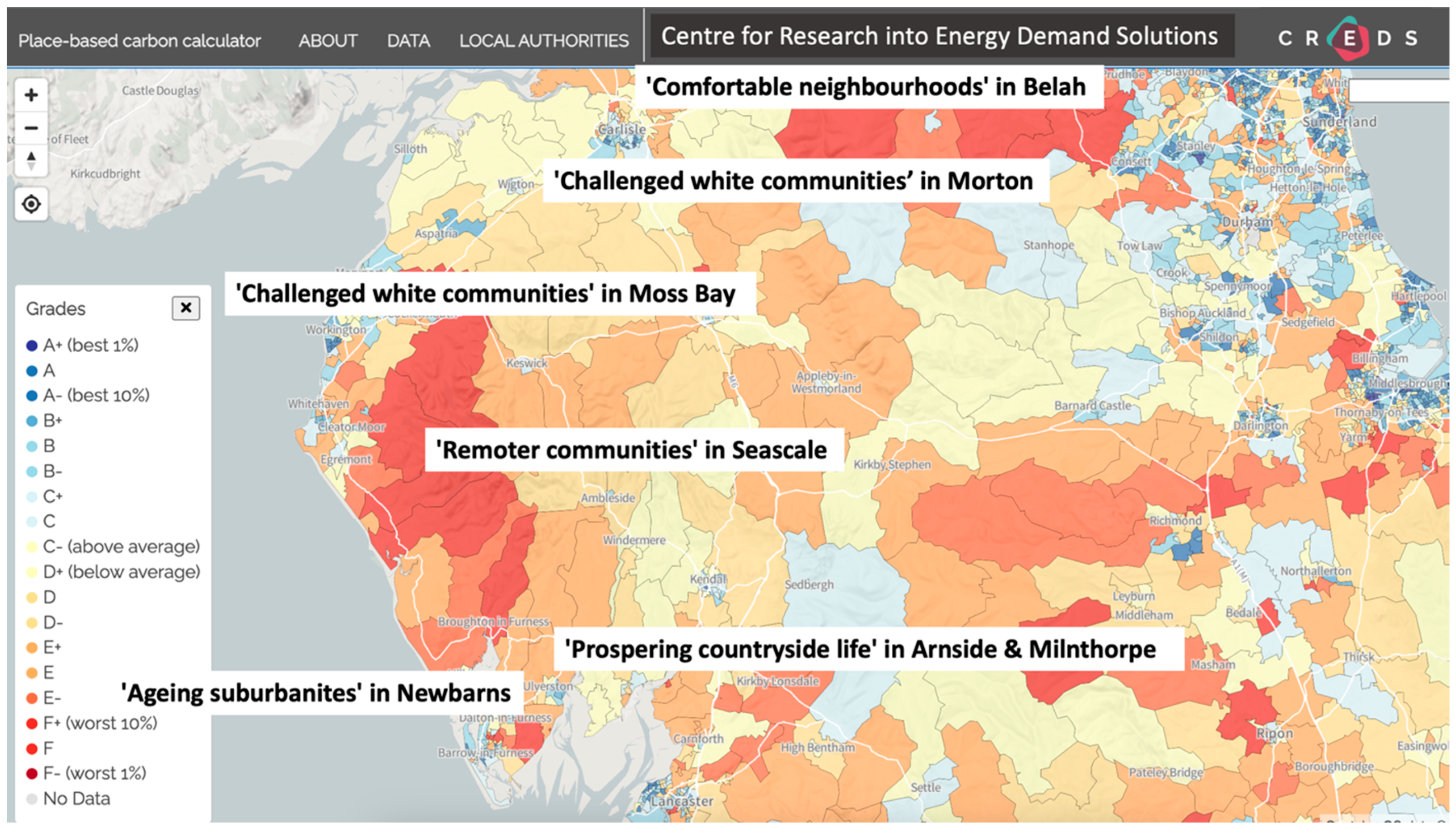
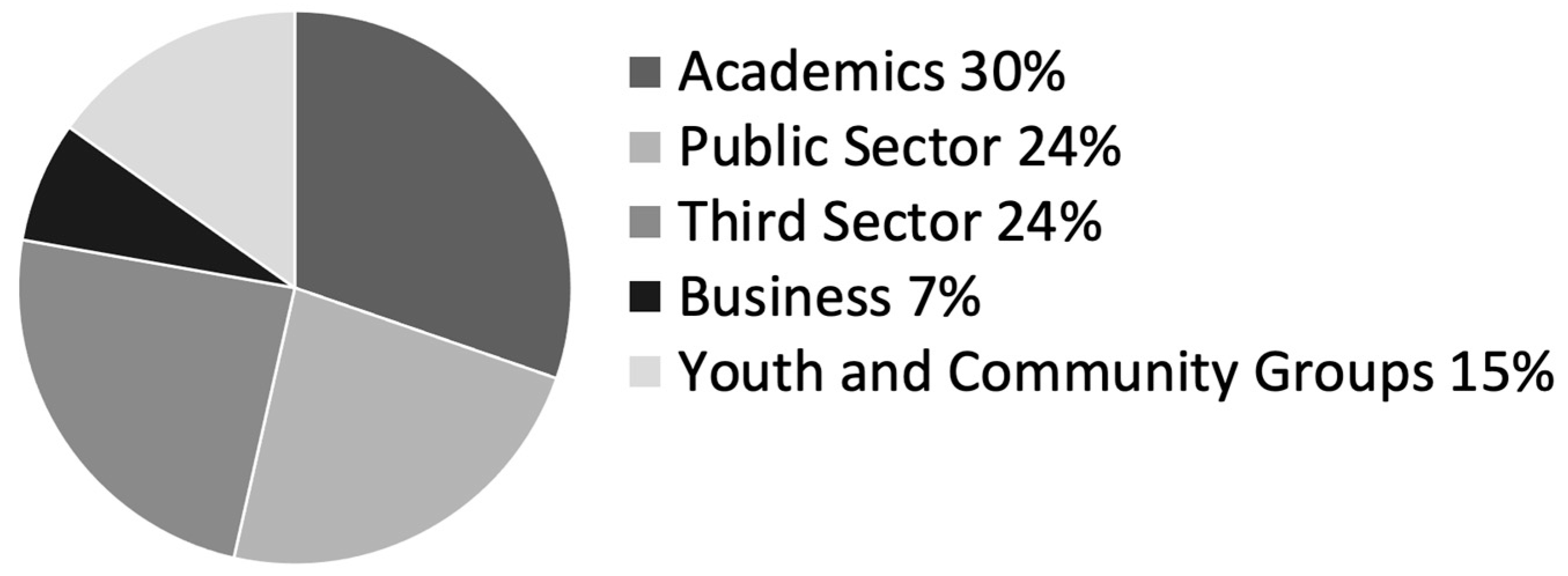

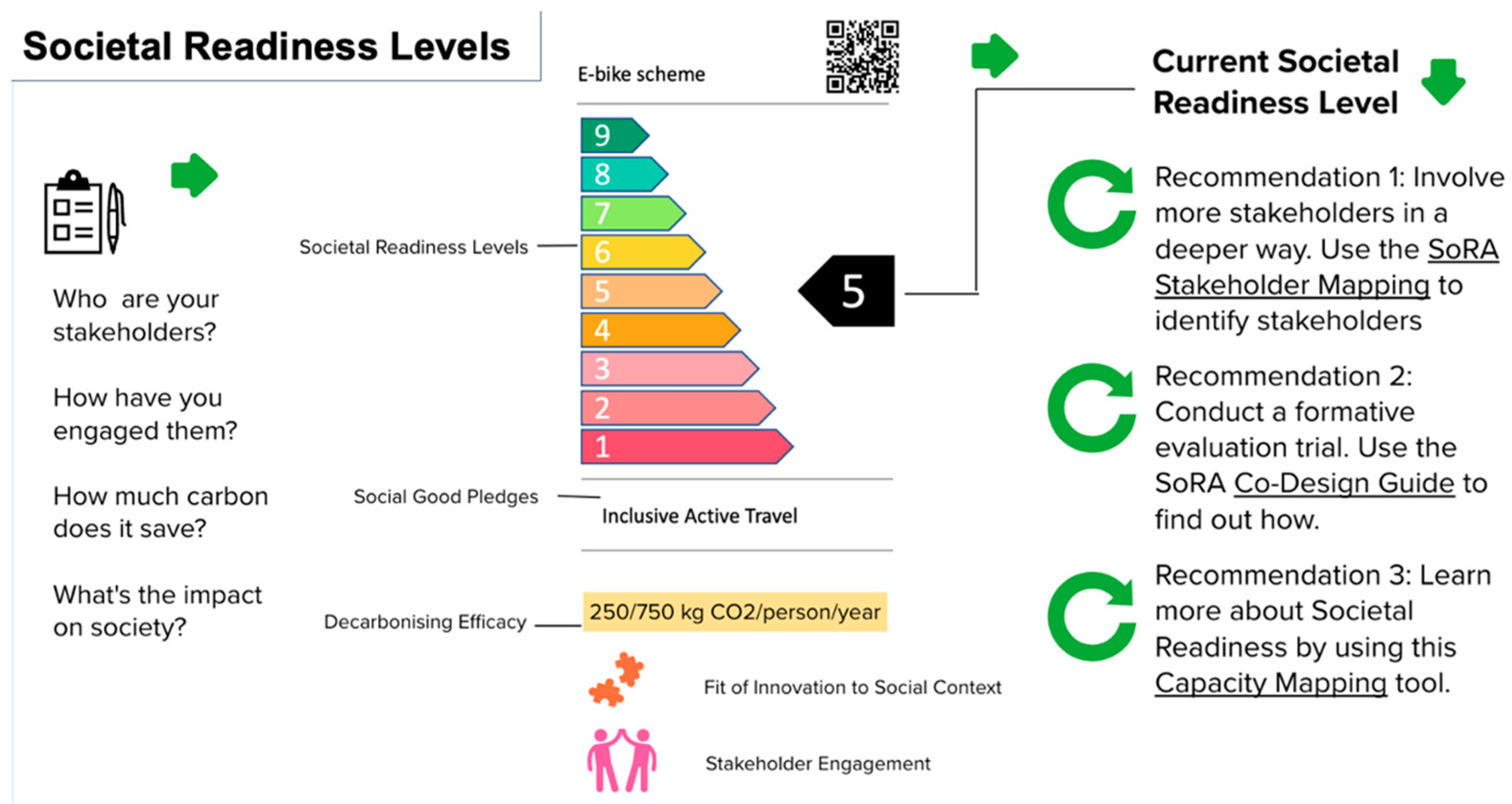
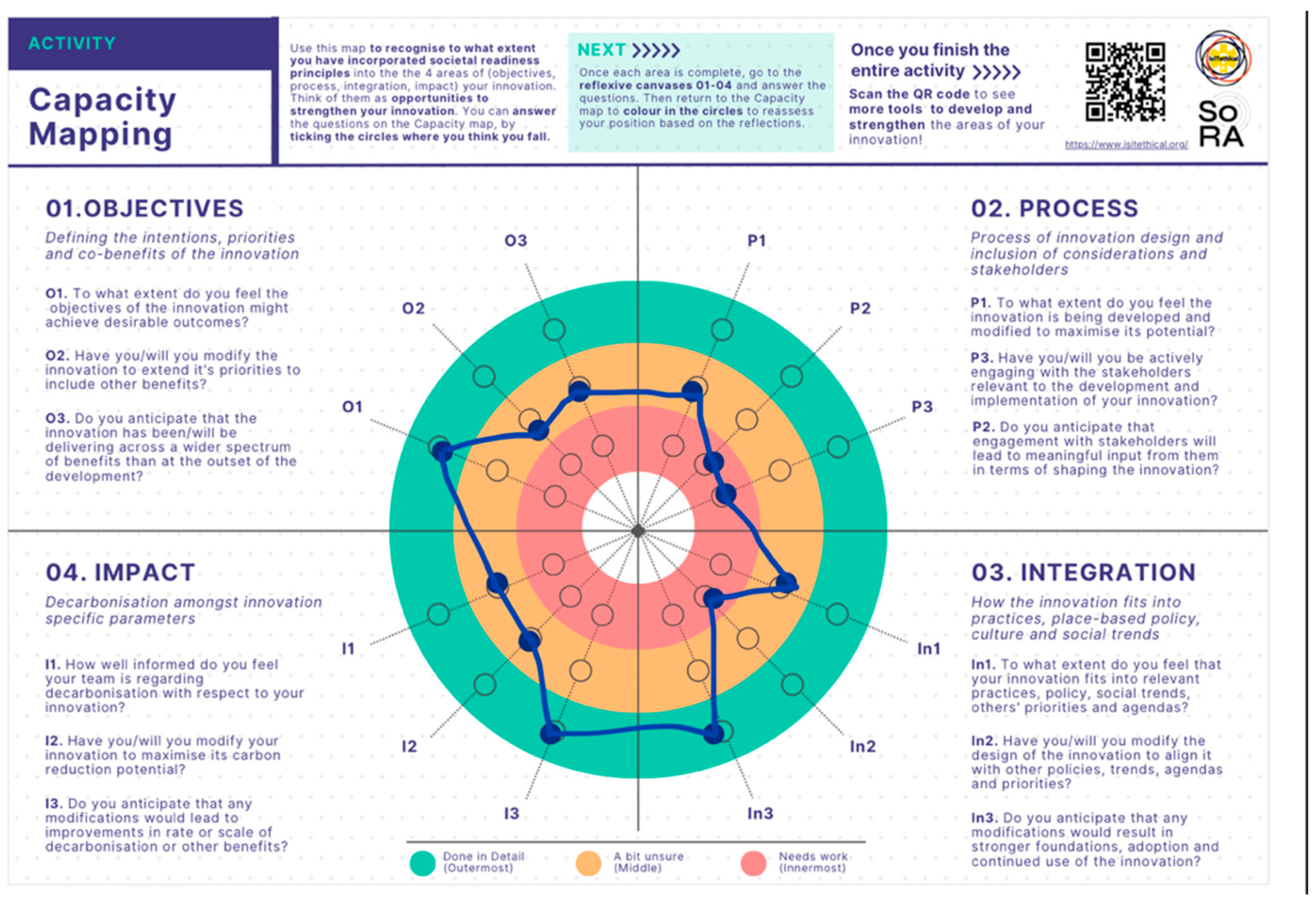
| TRL | Description NASA | Horizon 2020 | IPCC |
|---|---|---|---|
| TRL 1 | Basic principles observed. | Basic principles observed. | Initial idea (basic principles defined). |
| TRL 2 | Technology concept and/or application formulated. | Technology concept formulated. | Application formulated (technology concept and application of solution formulated). |
| TRL 3 | Analytical and experimental critical function and/or characteristic proof of concept. | Experimental proof of concept. | Concept needs validation (solutions need to be prototyped and applied). |
| TRL 4 | Component and/or breadboard validation in laboratory environment. | Technology validated in laboratory. | Early prototype (proven in test conditions). |
| TRL 5 | Component and/or breadboard validation in relevant environment. | Technology validated in relevant environment (industrially relevant environment in the case of key enabling technologies). | Full prototype at scale (components proven in conditions to be deployed). |
| TRL 6 | System/subsystem model or prototype demonstration in a relevant environment (ground or space). | Technology demonstrated in relevant environment (industrially relevant environment in the case of key enabling technologies). | Full prototype at scale (prototype proven as scale in conditions to be deployed). |
| TRL 7 | System prototype demonstration in a space environment. | System prototype demonstration in operational environment. | Precommercial demonstration (solutions working in expected conditions). |
| TRL 8 | Actual system completed and ‘flight qualified’ through test and demonstration (ground or space). | System complete and qualified. | First of a kind commercial (commercial demonstration, full scale deployment in final form). |
| TRL 9 | Actual system ‘flight proven’ through successful mission operations. | Actual system proven in operational environment (competitive manufacturing in the case of key enabling technologies; or in space). | Commercial operation in early environment (solution is commercial[sic] available, needs evolutionary improvement to stay competitive). |
| TRL 10 | Integration needed at scale (solution is commercial and competitive but needs further integration efforts). | ||
| TRL 11 | Proof of stability reached (predictable growth). |
| SRL | SoRA |
|---|---|
| SRL 1 | Basic principles of societal readiness and social good defined. |
| SRL 2 | Innovation-specific societal readiness concept formulated. |
| SRL 3 | Societal readiness concept evaluated with stakeholders. |
| SRL 4 | Societal readiness of prototypes evaluated with diverse stakeholders in test conditions. |
| SRL 5 | Societal readiness of prototypes evaluated with diverse stakeholders in a limited way in everyday life. |
| SRL 6 | Societal readiness of prototypes evaluated with diverse stakeholders examining full range of dissent through dialogue. |
| SRL 7 | Demonstration of societal readiness and social good through experiment and formative evaluation with stakeholders in expected conditions. |
| SRL 8 | Appropriation into everyday lives at a limited scale with demonstrable societal readiness and social good. |
| SRL 9 | Innovation integrated into a diversity of everyday lives, as part of ‘good life’ and other society systems. |
Disclaimer/Publisher’s Note: The statements, opinions and data contained in all publications are solely those of the individual author(s) and contributor(s) and not of MDPI and/or the editor(s). MDPI and/or the editor(s) disclaim responsibility for any injury to people or property resulting from any ideas, methods, instructions or products referred to in the content. |
© 2023 by the authors. Licensee MDPI, Basel, Switzerland. This article is an open access article distributed under the terms and conditions of the Creative Commons Attribution (CC BY) license (https://creativecommons.org/licenses/by/4.0/).
Share and Cite
Büscher, M.; Cronshaw, C.; Kirkbride, A.; Spurling, N. Making Response-Ability: Societal Readiness Assessment for Sustainability Governance. Sustainability 2023, 15, 5140. https://doi.org/10.3390/su15065140
Büscher M, Cronshaw C, Kirkbride A, Spurling N. Making Response-Ability: Societal Readiness Assessment for Sustainability Governance. Sustainability. 2023; 15(6):5140. https://doi.org/10.3390/su15065140
Chicago/Turabian StyleBüscher, Monika, Cronan Cronshaw, Alistair Kirkbride, and Nicola Spurling. 2023. "Making Response-Ability: Societal Readiness Assessment for Sustainability Governance" Sustainability 15, no. 6: 5140. https://doi.org/10.3390/su15065140
APA StyleBüscher, M., Cronshaw, C., Kirkbride, A., & Spurling, N. (2023). Making Response-Ability: Societal Readiness Assessment for Sustainability Governance. Sustainability, 15(6), 5140. https://doi.org/10.3390/su15065140




